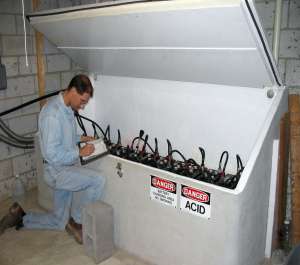Photovoltaics
The Photovoltaic (voltage from light) effect or the
process of utilizing sunlight to make electricity has been observed
since the 1800's. Sunlight shining directly on certain materials causes
the electrons in the molecules of those materials to become excited.
Given a path to follow, these electrons will flow in one direction,
creating electricity.
PV provides utility back-up power; keep your lights on when the power
goes out as well as other loads like wells, TV, fridge, computer,
garage door opener, alarm etc.. The use of a grid tie allows you the
ability to sell extra power back to the utility grid - Reduce your
utility bill by spinning your meter backwards. Good applications for PV
systems include utility back-up power, remote housing such as mountain
top were power lines may not be run and small lighting needs such as
sign and entrance lights that require additional lines.
The picture to your right shows one 115watt photovoltaic panel. Panels
come in sizes ranging from 5watts up. When you take a cluster of panels
and make an array you are capable of powering your entire house. A PV
system installed by CommonWealth Solar provides years of reliable
energy production.
|
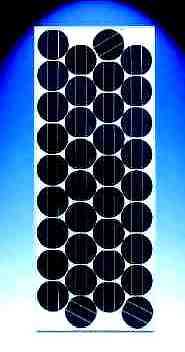
|
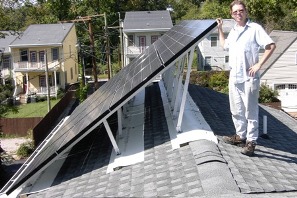
This is a 2.4kw system installed in 2009 with solar panels that
are more efficient and are also more commonly used in urbanized areas
as the cost effectiveness of panels and batteries have improved.
This is a battery Grid-Interactive system that provides net-metered
power offset most of the time - and backs up your power during outages.
It's like a generator that pays for itself the rest of
the time !

There are other forms of energy insecurity to consider as well that
battery backup solar systems are best positioned to address.
Please note that Commonwealth Solar systems are installed with flashing to the roof so that future
roof maintenance is easier and uses technology known by most competent
roofers.
|
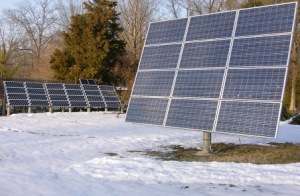
|
An array of photovoltaic panels is assembled to
collect the sun's energy. The number of panels that are used can
determine the amount of power supplied. The array to the left produces
2kw, and is backed up with a propane generator.
This system was installed in 1999 for an elderly woman.
|
Her system was later updated with a 5kw system one
third this size mounted on a tracker. (see an example of another
installation on the right).
She was intimately familiar with battery-based backup power. As a child
she watered the batteries for the old "Delco generator system"
before
the Rural Electrification Act of 1936 brought grid power to this rural
farm. Watering batteries is luckily no longer necessary.
On the right is another system that is mounted on
trackers that allow the PV panels to follow the sun. These are
motorized stands that turn to face the PV panel directly at the sun
from dawn till dusk, this maximizes their performance.
|
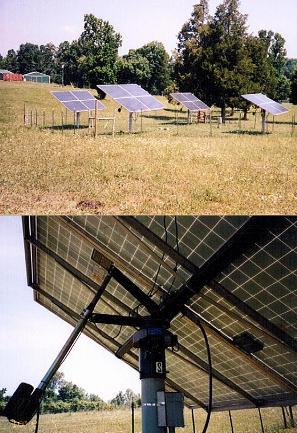
|
|
|
As the PV panels make electricity they charge a
battery bank such as the one to the left. This stores the power untill
it is needed such as in cloudy weather or at night. These battery banks
can be charged by different means such as PV, generator, or even the
utility grid.
Advanced charging algorithms are used to properly charge the battery
bank for maximum lifespan.
In contrast with that older photo above, the lower picture shows an
example of a current (March 2009) installation.
These are advanced Sealed Lead
Acid (SLA) batteries that
need no watering.
|
PV panels produce DC power; in order to convert this
to 240 volt (AC) power an inverter is used. The inverter is the brains
of the system; it tells the system where to get power and converts it
to a usable form. Each inverter produces 120 volt power so two units
are used and stacked in order to run larger appliances. At the top of
the inverters is a transfer switch used to manually switch from PV to
the grid. More advanced systems from Xantrex now sense the grid going
down and automatically disconnect while maintaining power to dedicated
circuits in your home or business.
|
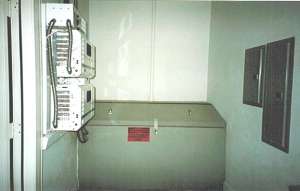
|
|



